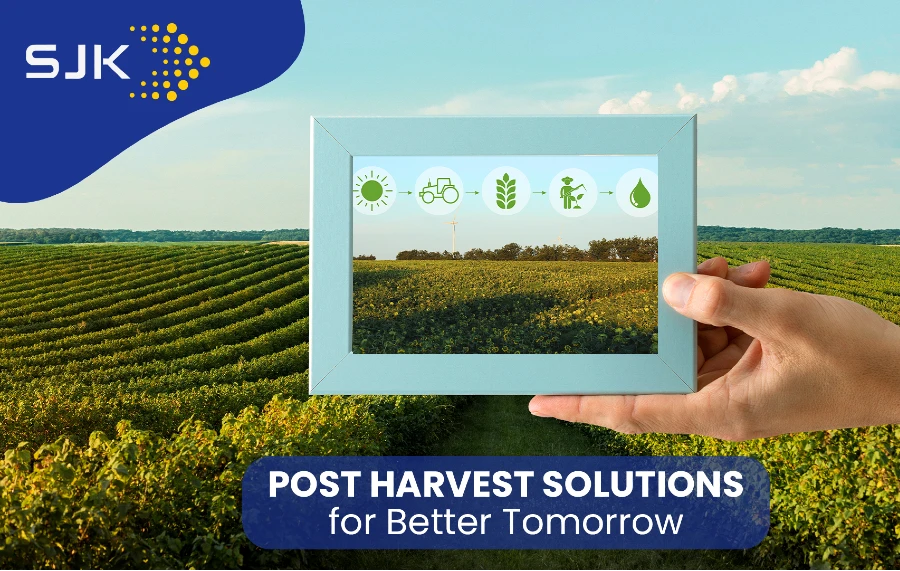Post Harvest Solutions for Better Tomorrow
In the world of agriculture, the moment of harvest is both a celebration of hard work and a critical juncture where the fate of crops is determined. However, the story doesn't end with the last sheaf gathered. Post-harvest management plays a pivotal role in ensuring food security, reducing waste, and paving the way for a sustainable future. In this blog, we'll delve into the importance of post-harvest solutions and explore how they can contribute to a better tomorrow.
The Challenge of Food Loss
Before we explore solutions, it's crucial to understand the scale of the challenge at hand. According to the Food and Agriculture Organization (FAO), approximately one-third of all food produced for human consumption is lost or wasted globally. This not only represents a significant economic loss for farmers but also exacerbates issues of hunger and environmental degradation.
The Ecological Footprint of Post-Harvest Losses
The impact of post-harvest losses extends beyond economic concerns. The resources invested in cultivating, harvesting, and transporting crops that ultimately go to waste contribute significantly to the ecological footprint of agriculture. By addressing post-harvest challenges, we can not only feed more people but also reduce the environmental impact of food production.
The Role of Post-Harvest Solutions
Post-harvest solutions encompass a range of practices and technologies designed to preserve and enhance the quality of harvested crops. These solutions address challenges such as spoilage, contamination, and transportation issues, ultimately minimizing food loss and increasing the efficiency of the entire food supply chain.
1. Improved Storage Facilities
One of the primary causes of post-harvest losses is inadequate storage facilities. Traditional methods, such as open-air storage, leave crops vulnerable to pests, diseases, and adverse weather conditions. Investing in modern storage facilities, equipped with climate control and pest management systems, can significantly extend the shelf life of harvested crops.
2. Cold Chain Infrastructure
For perishable goods, maintaining a cold chain is essential to preserving freshness and nutritional value. Establishing a robust cold chain—from farm to market—requires the integration of refrigerated transportation and storage facilities. This not only reduces food spoilage but also opens up new opportunities for farmers to access distant markets.
3. Drying and Preservation Techniques
In regions where excess moisture poses a threat to crops, drying techniques become invaluable. Solar drying, dehydrators, and other preservation methods can effectively reduce the water content of crops, preventing mold growth and deterioration. These techniques not only enhance the longevity of the harvest but also contribute to the development of value-added products.
4. Education and Training
Empowering farmers with knowledge and skills in post-harvest management is a sustainable solution in itself. Training programs can educate farmers on best practices, the proper use of technology, and the importance of timely harvesting. This not only enhances the overall efficiency of the agricultural process but also fosters a culture of innovation and adaptability.
5. Market Linkages
Connecting farmers directly with markets can minimize post-harvest losses by reducing the time and distance between production and consumption. Farmers' cooperatives, online platforms, and local markets can bridge this gap, ensuring that crops reach consumers quickly and efficiently.
As we stand at the crossroads of global challenges such as food security, climate change, and economic sustainability, investing in post-harvest solutions is not just an option; it's a necessity. By adopting modern storage practices, embracing technology, and fostering education, we can pave the way for a better tomorrow—one where the fruits of labor don't just feed the present but lay the foundation for a more resilient and sustainable future. Let us harvest not just crops but also hope for generations to come.

In conclusion, SJK Agro Solutions emerges as a beacon of innovation and sustainability in the realm of post-harvest management. By seamlessly integrating cutting-edge technologies, such as flat belt conveyors and fruit & vegetable bubble washers, SJK Agro Solutions addresses the critical issue of inadequate storage, safeguarding crops from pests and environmental challenges. The commitment to establishing a robust cold chain infrastructure aligns with the vision of reducing food spoilage and expanding market access for farmers. Furthermore, SJK's emphasis on education and training empowers farmers to implement best practices, fostering a culture of resilience and adaptability. As a holistic solution provider, SJK Agro Solutions not only mitigates post-harvest losses but also contributes to a more sustainable and efficient food supply chain. With SJK at the forefront, the agricultural landscape is poised for a transformative journey towards a better, more secure, and environmentally conscious tomorrow.

